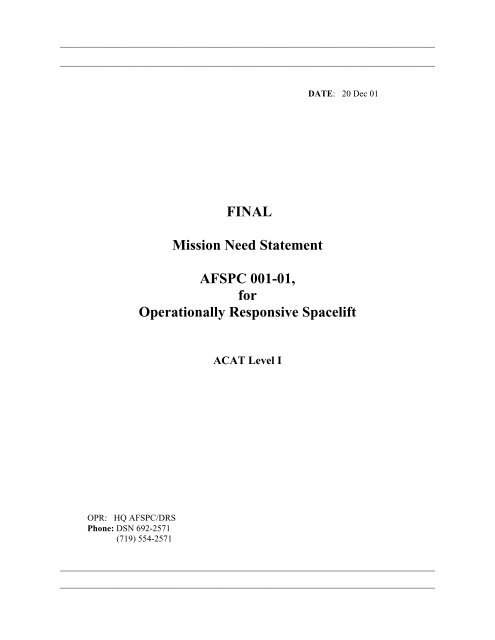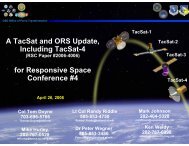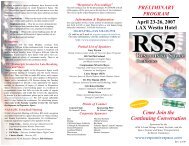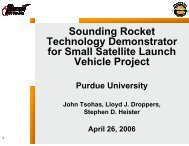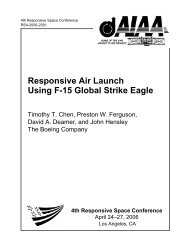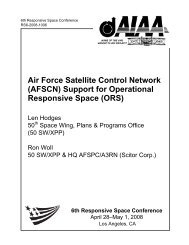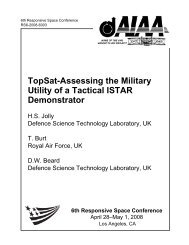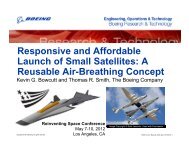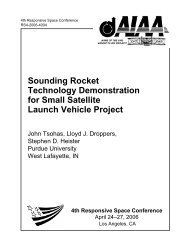FINAL Mission Need Statement AFSPC 001-01, for Operationally ...
FINAL Mission Need Statement AFSPC 001-01, for Operationally ...
FINAL Mission Need Statement AFSPC 001-01, for Operationally ...
You also want an ePaper? Increase the reach of your titles
YUMPU automatically turns print PDFs into web optimized ePapers that Google loves.
____________________________________________________________________________________________<br />
____________________________________________________________________________________________<br />
DATE: 20 Dec <strong>01</strong><br />
<strong>FINAL</strong><br />
<strong>Mission</strong> <strong>Need</strong> <strong>Statement</strong><br />
<strong>AFSPC</strong> <strong>0<strong>01</strong></strong>-<strong>01</strong>,<br />
<strong>for</strong><br />
<strong>Operationally</strong> Responsive Spacelift<br />
ACAT Level I<br />
OPR: HQ <strong>AFSPC</strong>/DRS<br />
Phone: DSN 692-2571<br />
(719) 554-2571<br />
____________________________________________________________________________________________<br />
____________________________________________________________________________________________
MISSION NEED STATEMENT<br />
FOR<br />
<strong>Operationally</strong> Responsive Spacelift<br />
<strong>AFSPC</strong> <strong>0<strong>01</strong></strong>-<strong>01</strong><br />
1. Defense Planning Guidance Element.<br />
1.1. Defense Planning Guidance. This <strong>Mission</strong> <strong>Need</strong> <strong>Statement</strong> (MNS) supports the FY 2003-2007<br />
Defense Planning Guidance (DPG), August 2<strong>0<strong>01</strong></strong>, Part II, Strategy Guidance. “The President has directed DoD<br />
to achieve progress in trans<strong>for</strong>ming the U.S. defense posture to meet the security challenges of the 21 st century.<br />
The aims of trans<strong>for</strong>mation are to maintain a substantial margin of advantage over potential adversaries in key<br />
functional areas of military competition (e.g., in<strong>for</strong>mation warfare, power projection, space, and intelligence)<br />
and mitigate the effects of surprise.”<br />
1.2. National Guidance. The 14 Sep 96 National Space Policy states, “DoD shall maintain the capability<br />
to execute the mission areas of space support, <strong>for</strong>ce enhancement, space control, and <strong>for</strong>ce application”; and<br />
“Consistent with treaty obligations, the U.S. will develop, operate and maintain space control capabilities to<br />
ensure freedom of action in space and, if directed, deny such freedom of action to adversaries.” US National<br />
Security Strategy (NSS) and National Military Strategy (NMS), as well as the current National and DoD space<br />
policies, identify uninhibited access to, and use of, space as critical strategic enablers of US military power.<br />
1.3. USSPACE/Joint Guidance. Assured Access [to Space], as described in the 1998 Long Range Plan<br />
(LRP) “is the “on-demand use” of space lines of communication to enable unimpeded operations in and through<br />
space. It’s essential to the conduct of space missions.” ORS supports both the LRP concepts <strong>for</strong> Assured Access<br />
and the Joint Vision 2020 operational concepts of Dominant Maneuver, Precision Engagement, Focused<br />
Logistics, In<strong>for</strong>mation Superiority, and Full-Dimension Protection.<br />
1.4. Air Force Guidance. The Air Force’s The Aerospace Force: Defending America in the 21 st Century<br />
states, “The country’s growing investment in, and reliance on, space-based capabilities that support the national<br />
in<strong>for</strong>mation and commercial infrastructure are creating an economic and military center of gravity--a<br />
vulnerability that, if exploited, could adversely affect the nation.” ORS provides the ability to enhance and<br />
reconstitute our current and future space-based capabilities, such as: intelligence, surveillance, and<br />
reconnaissance (ISR); navigation and timing; communications; weather data; future Force Application and<br />
Space Control missions that are critical to joint operations.<br />
2. <strong>Mission</strong> and Threat Analysis.<br />
2.1. <strong>Mission</strong> <strong>Need</strong>.<br />
2.1.1. <strong>Mission</strong> Description. ORS ensures the Air Force has the capability to rapidly put<br />
payloads into orbit and maneuver spacecraft to any point in earth-centered space, and to logistically support<br />
them on orbit or return them to earth. Once this capability is part of its space <strong>for</strong>ce mix, the Air Force will be<br />
postured to conduct the full spectrum of military activities required to ensure U.S. freedom of action, or defeat<br />
an enemy, in space. The conduct of these activities will be required <strong>for</strong> the United States to prevail in the<br />
increasingly operational medium of space. ORS supports eight of the Aerospace Power Functions listed in<br />
AFDD 1; Counterspace, Counterland, Strategic Attack, Counter-in<strong>for</strong>mation, Spacelift, Intelligence,<br />
Surveillance, and Reconnaissance. As operational requirements, cost-effectiveness, and technology allow,<br />
migrating military operations to space implements the vision of the USSPACECOM Long Range Plan;<br />
dominating the space medium through “Control of Space” and “Global Engagement” and integrating space<br />
<strong>for</strong>ces into warfighting capabilities through “Full Force Integration” and “Global Partnerships.”<br />
1
2.1.2. <strong>Mission</strong> Objectives. ORS is the key enabler <strong>for</strong> conducting the full spectrum of military<br />
operations in space and <strong>for</strong> achieving space superiority. ORS involves two sub-tasks. (1) Transporting <strong>Mission</strong><br />
Assets to, through, and from space. This task encompasses the spacelift missions of delivering payloads to, or<br />
from, mission orbit and changing the orbit of existing systems to better satisfy new mission requirements. It<br />
also supports emerging missions like space control, missile defense, and <strong>for</strong>ce application. ORS must be<br />
available on demand, flexible, and cost effective. The second sub-task, (2) Spacecraft Servicing, encompasses<br />
traditional satellite operations activities, but it could also include resupply, repair, replacement, and upgrade of<br />
space assets while in orbit. <strong>Mission</strong> priority, cost trades, and technological advances will dictate the method <strong>for</strong><br />
accomplishing these objectives.<br />
2.1.3. National Military Objectives. The Air Force supports national military objectives<br />
through a planning structure built on six Core Competencies. ORS is directly related to five of these Core<br />
Competencies; Aerospace Superiority, Precision Engagement, Rapid Global Mobility, In<strong>for</strong>mation Superiority,<br />
and Global Attack.<br />
2.1.4. Required Capabilities. ORS requires four key capabilities: (1) On-demand satellite<br />
deployment to augment and quickly replenish constellations to support crises and combat operations; (2) Launch<br />
to sustain required constellations <strong>for</strong> peacetime operations; (3) Recoverable, rapid-response transport to,<br />
through, and from space; and (4) Integrated space operations mission planning to provide near real-time<br />
automated planning to enable on-demand execution of space operations. Space systems providing ORS must<br />
possess the following characteristics:<br />
2.1.4.1. Responsive. ORS systems must be ready to launch within hours of call-up,<br />
and to conduct military operations within hours of reaching orbit. Spacelift, and the supported space assets,<br />
must be able to quickly respond to a dynamic threat environment, changing mission requirements, and increased<br />
operational tempos and utilization rates. It is recognized that responsive payloads must be developed<br />
concurrently with ORS to provide maximum benefit to the warfighter.<br />
2.1.4.2. Maneuverable. Once on orbit, ORS systems must have the maneuverability to<br />
rapidly achieve any earth-centered orbit (usually with an orbital period of 24 hours or less) to deliver, operate,<br />
recover, or service mission assets. In the far term, these spacecraft will require the ability to maneuver from one<br />
orbit to any other orbit in less than 48 hours from call-up.<br />
2.1.4.3 Operable. ORS systems must be available and dependable to support mission<br />
needs. They must also be reliable, supportable, maintainable, and robust enough to generate required mission<br />
rates. If reusable launch vehicles are used, they must be capable of meeting required turnaround-times.<br />
Operational restrictions, due to weather, ranges, and the space environment, must be minimized.<br />
2.1.4.4. Economical. ORS systems must provide a cost-effective means of executing<br />
DoD missions.<br />
2.1.4.5. Survivable. ORS systems must execute their mission in spite of threats posed<br />
by adversaries (see para 2.2.). In some cases, they must also survive repeated and/or long-term exposure to the<br />
space environment and descent through the atmosphere.<br />
2.1.4.6. Interoperable. Components of ORS systems will, to the maximum extent<br />
practical, be interoperable with joint and allied; operations concepts, command and control concepts, equipment,<br />
and facilities. Interoperability with NASA and commercial space facilities and equipment should also be<br />
maximized. At a minimum, these systems must meet Command, Control, Communications, Computers,<br />
Intelligence, Surveillance, and Reconnaissance (C4ISR) Joint Technical Architecture (JTA) standards to allow<br />
the total integration of all intelligence, deterrence, and warfighting capabilities available to the CINCs, National<br />
Command Authority, and other users.<br />
2.1.4.7. Flexible. ORS systems must possess the capability to orbit a variety of payloads<br />
to support multiple theaters, with possibly conflicting and simultaneous requirements.<br />
2
2.2. Threat Environment. The primary threats to ORS are physical and in<strong>for</strong>mation collection threats.<br />
An overview of threats against this mission area can be found in; “National Intelligence Estimate 99-15, (U)<br />
Threats to US Space Systems and Operations”, dated October 1999 (S//NF). DIA validated threat documents<br />
include: “NAIC-1574-0210-00, (U) Automated In<strong>for</strong>mation Systems Threat Environment Description”, dated<br />
September 2000 (S//NF//MR); and “NAIC-1574-0727-<strong>01</strong>, (U) Space Systems Threat Environment Description”,<br />
dated January 2<strong>0<strong>01</strong></strong> (S//NF//MR).”<br />
2.2.1. Counterspace Forces: Physical threats to space systems and operations include directed<br />
energy, kinetic energy, and nuclear weapons, jamming (EMI), and sabotage against ground stations.<br />
2.2.2. Espionage: In<strong>for</strong>mation collection ef<strong>for</strong>ts will target national security assets and/or space<br />
systems operations, technologies, manufacturing processes, and logistical networks.<br />
2.2.3. Sabotage: Physical threats exist to space systems payloads, fuels, spacecraft production<br />
facilities, transportation, ground operations, software, and command and control facilities. The threat of a<br />
chemical, biological, radiological, or nuclear attack must be considered.<br />
2.2.4. In<strong>for</strong>mation Warfare: The threat of In<strong>for</strong>mation Attack exists <strong>for</strong> military space systems<br />
communications links and relays; including command and control networks, as well as worldwide<br />
communication and tracking networks.<br />
2.2.5. Nuclear Forces: A threat to space systems from nuclear <strong>for</strong>ces exists. This includes<br />
prompt effects from nuclear weapons detonated in orbit as well as an increase in background radiation in the<br />
Van Allen belts as a result of such detonations.<br />
2.3. Deficiencies and Shortfalls of Existing Capabilities. Today, space activities are constrained by a<br />
lack of operational flexibility and responsiveness, high costs, and a limited on-orbit maneuver capability.<br />
Current launch systems require months of preparation time. As a consequence, the DoD was unable to orbit any<br />
new payloads in time to affect the outcome of Desert Storm. At about $10,000/lb to low-earth orbit, high launch<br />
costs substantially limit the number of payloads we can af<strong>for</strong>d to put into space. Current systems also lack<br />
substantial maneuver capability, which limits our ability to conduct military operations in space. The 1999<br />
<strong>AFSPC</strong> <strong>Mission</strong> Area Plan identified the following top needs, which relate directly to <strong>Operationally</strong> Responsive<br />
Spacelift. In priority order, they are; On-demand Space Asset Launch and Initialization, Increase Launch<br />
Throw-Weight, Rapid Transportation Through Space, Increase Launch Rate, Recover On-Orbit Space Assets,<br />
Service On-Orbit Space Assets, and Rapid Space Asset Repositioning. USCINCSPACE identified the lack of<br />
recoverable, rapid transport to, through, and from space as a critical capability needed by 2<strong>01</strong>2.<br />
2.4. Timing and Priority of <strong>Need</strong>. ORS is a high priority. The DoD’s ability to execute space missions,<br />
as defined in National Space Policy, depends on the Air Force to promptly deliver mission assets to, through,<br />
and from space. The immediacy of this need is highlighted by the growing threat to US space-based<br />
capabilities, the increasing dependence on space capabilities <strong>for</strong> military operations, and the nation’s overall<br />
growing reliance on services provided by the space infrastructure. A timeline <strong>for</strong> developing new military space<br />
systems is described below.<br />
2.4.1. The need exists today to assure prompt delivery of mission assets to, through, in, and<br />
from space. A single satellite failure, natural or induced, may significantly degrade or entirely eliminate critical<br />
<strong>for</strong>ce enhancement (e.g., warning, reconnaissance, communications, weather, navigation, and timing) to a wide<br />
range of users. These users include warfighters, as they engage enemy <strong>for</strong>ces, and the National Command<br />
Authority as they contemplate alternative courses of action. The time required to replace these capabilities is<br />
currently measured in months or years. ORS systems are essential <strong>for</strong> reducing the time required to augment or<br />
reconstitute these vital space-based capabilities from months to days or, in a best case, hours.<br />
2.4.2. In the near-term (2-9 years), demand <strong>for</strong> more timely and precise space <strong>for</strong>ce<br />
enhancement (e.g., C4ISR) and the deployment of space control systems to space will lead to an increased<br />
variety of mission profiles <strong>for</strong> space assets. Specifically, future missions will include a wide range of payload<br />
3
functions, orbit types, times over target, mission duration, users, and self-protection capabilities. <strong>Operationally</strong><br />
Responsive Spacelift, particularly in terms of maneuverability and responsiveness, is required to meet these<br />
emerging mission demands.<br />
2.4.3. In the mid-term (10-15 years), protecting and sustaining space capabilities will be<br />
instrumental in protecting national security and commercial interests. The success of U.S. military <strong>for</strong>ces will<br />
depend heavily on our ability to control space and to provide space-based capabilities <strong>for</strong> navigation,<br />
intelligence, surveillance and reconnaissance (ISR), Meteorology and Oceanography (METOC) predictions that<br />
support targeting and delivery of precision munitions, and Theater/National Missile Defense. As such, ORS will<br />
be an essential element in satisfying critical and evolving military requirements <strong>for</strong> prompt operations to,<br />
through, in, and from space. Current National Space Policy (14 Sep 96) states that space superiority must be<br />
maintained through all levels of conflict. An ORS capability is also required to satisfy the space support needs<br />
of; on-demand space asset launch and initialization, increased launch rate, on-orbit servicing, and rapid asset<br />
repositioning.<br />
3. Non-Materiel Alternatives. There are no changes to doctrine, organization, training, leadership, or personnel<br />
that will fully meet the need.<br />
4. Potential Materiel Alternatives. Materiel solutions that may satisfy the need <strong>for</strong> <strong>Operationally</strong> Responsive<br />
Spacelift fall into three broad categories. These categories are; (1) a new system, specifically designed <strong>for</strong> ORS,<br />
(2) evolution of current expendable launch systems into an ORS system, or (3) commercially provided launch<br />
services.<br />
4.1. A multi-purpose military space system, specifically designed <strong>for</strong> ORS, is one potential materiel<br />
alternative. The key elements of this system are reusable components, launch-on-demand, and enhanced orbital<br />
maneuverability to allow spacecraft to per<strong>for</strong>m large changes in inclination and altitude. The Air Force, NASA,<br />
and commercial companies are exploring various concepts and approaches. Air Force concepts include the<br />
Space Operations Vehicle (SOV), the Space Maneuver Vehicle (SMV), and Orbit Transfer Vehicle (OTV).<br />
NASA’s Space Launch Initiative may achieve substantial advances towards an ORS vehicle. Commercial<br />
concepts include Single Stage and Two Stage to Orbit reusable launch systems and Air Launch concepts that use<br />
large transport aircraft as a first stage.<br />
4.2. A second materiel alternative is to evolve an ORS system from current and projected expendable<br />
launch vehicles, including retired ICBMs. The Evolved Expendable Launch Vehicle (EELV) promises a<br />
significant reduction in launch costs and preparation time. Other advances in expendable launch vehicle<br />
technology may provide further reductions in launch cost and preparation time. These advances, combined with<br />
responsive payloads, may provide a means of achieving a launch-on-demand capability. Alternatively, a portion<br />
of this capability might be achieved through the application of those ICBM alert procedures that keep a booster<br />
continuously ready to launch. A combination of expendable launchers, along with the SMV and OTV concepts,<br />
may provide the necessary spacelift and on-orbit maneuver capability.<br />
4.3. Another possibility is the use of commercially provided launch services. Under this concept, the<br />
DoD would contract <strong>for</strong> the required launch services. The prime contractor would be responsible <strong>for</strong> acquiring<br />
boosters and delivering payloads to orbit. The user would buy the launch upon checkout of the asset in its<br />
operational orbit. Whereas this concept has been successfully used in the past <strong>for</strong> routine launch operations, its<br />
limitations in responsiveness, security, and flexibility make it unsuitable <strong>for</strong> spacelift roles supporting inherently<br />
military missions such as space control and <strong>for</strong>ce applications. However, commercial launch operations may be<br />
a viable option <strong>for</strong> routine (i.e., scheduled) satellite launches where applicable security, cost, and timeliness<br />
criteria are met.<br />
4
5. Constraints.<br />
5.1 Key Boundary Conditions.<br />
5.1.1. National Policy. ORS must comply with US law, national and DoD space policy,<br />
military doctrine, as well as applicable arms control agreements. For example, ORS must comply with the 1967<br />
Outer Space Treaty, which prohibits placing nuclear weapons and other weapons of mass destruction in earth<br />
orbit, installing them on celestial bodies, or otherwise stationing them in outer space.<br />
5.1.2. Logistics Support. ORS must be completely supportable within DoD maintenance<br />
principles and emphasize lean, responsive, and economical support systems. The systems must employ<br />
appropriate logistics support and maintenance procedures to provide responsive mission integration,<br />
preparations, and operations. Reliability, maintainability, supportability, and disposal considerations must be<br />
emphasized to meet readiness and life cycle cost objectives.<br />
5.1.3. Transportation. Transportation support processes and procedures must be considered<br />
throughout. Provisions may be necessary <strong>for</strong> the unique requirements associated with the handling, control, and<br />
security of the systems.<br />
5.1.4. Manpower, Personnel, and Training. Military space systems may be operated by trained<br />
contractor personnel, military personnel, or a military-contractor combination. The user will determine<br />
operations, maintenance, logistics support manning, and critical mission tasks. ORS systems will utilize<br />
automation, simulators, and robotics, as appropriate, to minimize manpower requirements. Training and training<br />
systems, such as simulators, must be integrated with the ORS systems architecture.<br />
5.1.5. Security. Program protection plans will be applied throughout the life cycle to maintain<br />
technical superiority, system integrity, and availability. The system security must safeguard critical system<br />
elements, technologies and in<strong>for</strong>mation through employment of physical, communications, computer, personnel,<br />
in<strong>for</strong>mation and operations security measures and prevent inadvertent or malicious technology transfer to<br />
unauthorized users.<br />
5.1.6. Standardization and Interoperability. The system must have Command, Control,<br />
Communications, Computers and Intelligence (C4I) capabilities which ensure, as a minimum, complete<br />
integration with existing and programmed C4I systems. System design must support the interoperability goals<br />
established in the C4I <strong>for</strong> The Warrior (C4IFTW) concept tenets. System managers must con<strong>for</strong>m to governing<br />
Interoperability and Standardization (I&S) directives. C4I supportability and sustainability must be maximized<br />
in the design, operation, and modification of the system, throughout its life cycle.<br />
5.2. Operational Environment. ORS operations must not be substantially degraded by environmental<br />
conditions, either in space or in the Earth’s atmosphere. Some operations must continue despite adverse<br />
environmental conditions such as radiation, solar flares, debris, atmospheric friction, rain, freezing precipitation,<br />
or high winds. The systems must be able to operate successfully in the following hostile environments;<br />
In<strong>for</strong>mation Warfare (IW), Command and Control Warfare (C2W), Electronic Warfare (EW), and GPS<br />
jamming. Forward-deployed ground segments must be capable of operating in an environment contaminated by<br />
chemical, and/or biological agents. Systems safety, ground safety and space safety programs are required and<br />
will comply with the latest DoD policies.<br />
6. Joint Potential Designator. ORS systems are Joint Interest programs with USSPACECOM as their ultimate<br />
user. They support the following Joint Warfighting Capability Assessment (JWCA) categories; Dominant<br />
Maneuver, Precision Engagement, Focused Logistics, Full Dimensional Protection, In<strong>for</strong>mation Superiority,<br />
Intelligence, Surveillance & Reconnaissance (ISR), Communications/Computer Environment, and Strategic<br />
Deterrence.<br />
5


